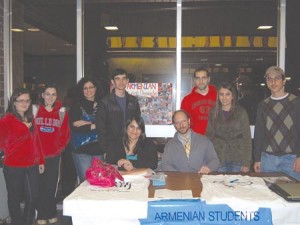Andrew Esguerra
Staff Writer

Photo: Erica Magarian
On Wednesday, April 7th, Dr. Sergio La Porta, Haig and Isabel Berberian Professor of Armenian Studies at Fresno State, explored connections between the works of famed nineteenth century Armenian poets Bedros Tourian, Daniel Varujan, and Eghishe Charents to the medieval Italian poet Dante Alighieri (1265-1321), the author of the Divine Comedy.
The three parts of the Divine Comedy—the Inferno, Purgatorio, and Paradiso—depict Dante’s journey from Hell, to Purgatory, and eventually to Paradise. One of the remarkable aspects of the poem is that it represents a pioneering work in the Italian language; until that time serious literature was written in Latin.
Dr. La Porta noted shared resonances between the Armenian poets and Dante. Although Dante was writing centuries earlier, Dr. La Porta pointed out that Armenian culture experienced a renaissance (zart‘onk‘, awakening, in Armenian) during the course of the nineteenth century. One aspect of that renaissance was the emergence of Modern Armenian as a literary language. In Dante’s laying of the foundation of the modern Italian language, Dr. La Porta suggested, Armenian writers saw a kindred enterprise to their own undertaking. Another aspect of the Armenian renaissance was the number of translations from classical and contemporary European literature first into classical Armenian and then into modern Armenian. Dr. La Porta described the numerous attempts of Armenian translators to render the Divine Comedy from the nineteenth century to the present. Particularly important in this regard were the efforts of the Mkhit‘arist fathers in Venice.
Dr. La Porta then speculated on how three modern Armenian poets were informed by Dante’s Inferno. He first discussed Bedros Tourian’s “Murmurs.” Tourian (1851-72) invigorated modern Armenian with his poetry, although he died at the young age of 21. While it is uncertain that Tourian read Dante, it is possible that he read some of the early translation of parts of the Inferno. Dr. La Porta suggested that Tourian’s image of himself as a dry leaf in autumn about to fall was inspired by Dante’s use of leaves falling in autumn to describe souls rushing to the boatman Charon to cross into the underworld.
The next poet Dr. La Porta discussed was Daniel Varujan (1884-1915). He indicated similarities between Varujan’s poem, “The Light,” and Dante’s Inferno, particularly Canto 1. He stressed that Varujan did not simply mimic Dante, but transformed Dante’s pilgrimage into a personal journey to find poetic inspiration.
Finally, Dr. La Porta looked at the famous Eastern Armenian poet, Eghishe Charents (1897-1937). He remarked that Dante clearly featured in Charents’s imagination throughout his life and we can almost trace the modern poet’s reading of Dante from youth through the end of his life. One of the earliest of Charents’s works is entitled “Dantean Legend,” written in 1915-16. It was written during his time as a volunteer soldier fighting against the Turkish army after the destruction of the region of Van at the outset of the Armenian Genocide. The poem is not only about the death and destruction of war, but also about the loss of innocence, of youth, and the gradual loss of life and its meaning. Although allusions to the Inferno abound in the text, Dr. La Porta underscored that it was how Charents’s text differs from Dante’s that makes the Armenian poem so powerful. He especially noted that Charents does not descend into Hell, but that Hell manifests itself on earth.
Dr. La Porta then turned to Charents’s poem, “Vision of Death”, composed when Charents was 36, and which adopts a more formalistic resemblance to the Inferno. The poet travels into the underworld, guided by Dante himself, and meets with various Armenian ideologues. According to Dr. La Porta, Charents’s journey into hell is into the past, and into the vain glorifications of the nation; his paradise is defined by communism, “the steed that is heading into the future”.
Dr. La Porta finally looked at a posthumously published poem of Charents in which he describes waking up in his study and looking at a portrait of Dante and Petrarch in paradise. The poem was likely written in the final year of Charents’s life before he was arrested by the Stalinist authorities and after he had already been isolated and betrayed by many of his fellow artists and compatriots. According to Dr. La Porta, in this poem Dante’s meaning for Charents has once again transformed; “he—along with Petrarch, that other father of the Italian language—represents the one who can write his way into heaven.”
 Hye Sharzhoom Armenian Action
Hye Sharzhoom Armenian Action